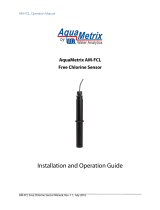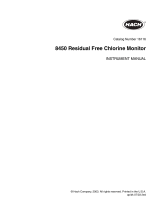
EN 3
ASEKO CLF Probe
The ASEKO CLF probe is intended for measurement of free chlorine con-
tent in water. The unique structure of the membrane probe with the built-in
electronics makes it possible to use the free chlorine probe even under
conditions where other probes cannot be used. The probe is designed
tobescrewed into a fl ow well being part of ASIN Aqua automatons con-
trolling pool water quality.
Theory
Free chlorine is a compound of gaseous chlorine (Cl2), hypochlorous acid
(HOCl), and hypochlorite (OCl–). All molecular chlorine above pH 4.0 is con-
verted to HOCl and OCl–. Hypochlorous acid is a more active disinfectant
than hypochlorite, exists in balance and depends on pH. Free chlorine also
combines with naturally existing or artifi cially delivered nitrogen compounds
in water while producing chloramine, also known as bound chlorine.
Ammonia brought by users to pool water produces chloramines. Monochlo-
ramine (NH2Cl), chloramine (SnCl2), and trichloramine (NCl3) are less
active as disinfectants but they have longer lifetime than free chlorine. Total
chlorine is a compound of free chlorine (Cl2, HOCl, and OCl–) and bound
chlorine (NH2Cl, NHCl2, NCl3).
The CLF probe principle is based on two electrodes (anode and cathode)
that measure a current change caused by chemical reduction of hypochlor-
ous acid on the cathode. Current fl owing due to this reduction is proportional
to chlorine concentration. The membrane and electrolyte help control this
Technical specifi cation
32 g (without electrolyte)
CLF calibration stability
0-1 bar (not under pressure)









